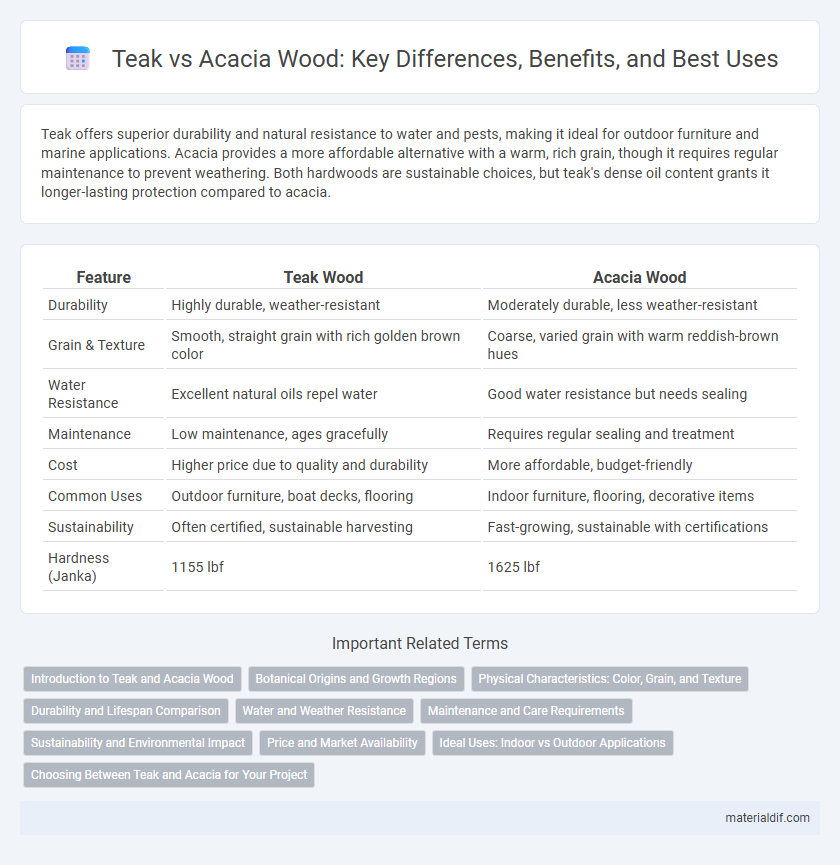Teak offers superior durability and natural resistance to water and pests, making it ideal for outdoor furniture and marine applications. Acacia provides a more affordable alternative with a warm, rich grain, though it requires regular maintenance to prevent weathering. Both hardwoods are sustainable choices, but teak's dense oil content grants it longer-lasting protection compared to acacia.
Table of Comparison
| Feature | Teak Wood | Acacia Wood |
|---|---|---|
| Durability | Highly durable, weather-resistant | Moderately durable, less weather-resistant |
| Grain & Texture | Smooth, straight grain with rich golden brown color | Coarse, varied grain with warm reddish-brown hues |
| Water Resistance | Excellent natural oils repel water | Good water resistance but needs sealing |
| Maintenance | Low maintenance, ages gracefully | Requires regular sealing and treatment |
| Cost | Higher price due to quality and durability | More affordable, budget-friendly |
| Common Uses | Outdoor furniture, boat decks, flooring | Indoor furniture, flooring, decorative items |
| Sustainability | Often certified, sustainable harvesting | Fast-growing, sustainable with certifications |
| Hardness (Janka) | 1155 lbf | 1625 lbf |
Introduction to Teak and Acacia Wood
Teak wood, known for its exceptional durability and natural oil content, resists water, insects, and decay, making it ideal for outdoor furniture and marine applications. Acacia wood is prized for its strength, dense grain, and rich, varied color tones, offering an affordable yet hardy alternative for indoor furniture and flooring. Both woods are valued for their aesthetic appeal and resilience, but teak's superior weather resistance sets it apart.
Botanical Origins and Growth Regions
Teak (Tectona grandis) is native to South and Southeast Asia, predominantly found in India, Myanmar, Thailand, and Laos, thriving in tropical hardwood forests with a preference for well-drained fertile soils. Acacia encompasses over 1,000 species, primarily native to Australia and Africa, with Acacia mangium and Acacia nilotica being notable for timber; these species adapt to diverse climates from arid to tropical regions. The distinct botanical origins and growth environments influence their wood characteristics, with teak's dense, oily grain contrasting the generally lighter and more porous acacia varieties.
Physical Characteristics: Color, Grain, and Texture
Teak wood displays a warm golden-brown hue that darkens with age, featuring a straight grain and a smooth texture known for its natural oils and durability. Acacia wood varies from light amber to rich reddish-brown, often with distinctive wavy or irregular grain patterns and a coarse texture, offering a rustic and vibrant appearance. The high oil content in teak makes it more resistant to moisture and decay, while acacia's dense fibers and hardness provide strong wear resistance despite its less uniform texture.
Durability and Lifespan Comparison
Teak wood is renowned for its exceptional durability, exhibiting high resistance to rot, insects, and harsh weather conditions, making it ideal for outdoor furniture with a lifespan exceeding 50 years. Acacia wood offers good durability with moderate resistance to decay and is suitable for indoor and sheltered outdoor use, typically lasting around 10 to 20 years under proper maintenance. The natural oils and dense grain of teak contribute to its superior longevity compared to acacia, which requires regular treatment to enhance its lifespan and durability.
Water and Weather Resistance
Teak wood boasts exceptional water resistance due to its natural oils and dense grain, making it highly durable in rainy and humid environments. Acacia offers moderate weather resistance with good hardness, but it lacks the natural oils that provide teak with superior protection against moisture and decay. For outdoor furniture exposed to frequent rainfall, teak outperforms acacia in maintaining structural integrity and resisting weather-related damage.
Maintenance and Care Requirements
Teak wood requires minimal maintenance due to its natural oils that resist moisture, insects, and decay, making it ideal for outdoor furniture with just occasional cleaning and oiling needed. Acacia wood demands more frequent care, including regular sealing or oiling to prevent drying, cracking, and weather damage, especially in outdoor settings. Proper maintenance extends the longevity of both woods, but teak's high natural durability significantly reduces upkeep efforts compared to acacia.
Sustainability and Environmental Impact
Teak wood, known for its durability and natural oil content, requires longer growth periods and is often harvested from plantations to reduce deforestation impact. Acacia wood grows faster, making it a more renewable resource with a lower environmental footprint, especially when sourced from managed forests. Both woods contribute to sustainable practices, but acacia's rapid growth and carbon sequestration capacity generally offer a more eco-friendly choice.
Price and Market Availability
Teak wood commands a higher price due to its natural oils, durability, and resistance to pests, making it a premium choice in the furniture and flooring markets. Acacia wood is more affordable and widely available, benefiting from faster growth rates and abundant plantations globally, particularly in tropical regions. Market availability for teak is limited by slower growth and strict export regulations, while acacia's accessibility supports larger-scale production and diverse applications.
Ideal Uses: Indoor vs Outdoor Applications
Teak wood is highly resistant to moisture, decay, and insect damage, making it ideal for outdoor applications such as decking, patio furniture, and boat building. Acacia wood, while durable and attractive with its rich grain patterns, is better suited for indoor use including furniture, cabinetry, and flooring, as it is less weather-resistant than teak. Both woods offer hardness and aesthetic appeal, but teak's superior natural oils provide enhanced protection against outdoor elements.
Choosing Between Teak and Acacia for Your Project
Teak offers exceptional durability and natural resistance to water and pests, making it ideal for outdoor furniture and decking projects. Acacia, known for its affordability and rich, varied grain patterns, suits indoor furniture and decorative pieces requiring a warm aesthetic. When choosing between Teak and Acacia, consider factors like environmental exposure, budget constraints, and desired wood grain appearance to ensure the best fit for your project's longevity and style.
Teak vs Acacia Infographic

 materialdif.com
materialdif.com